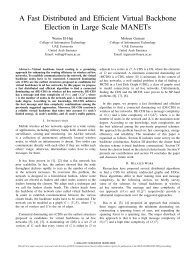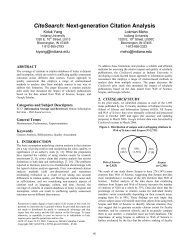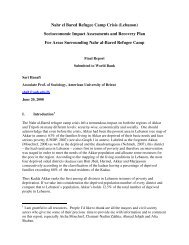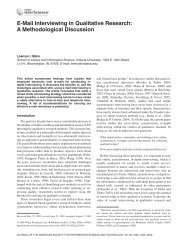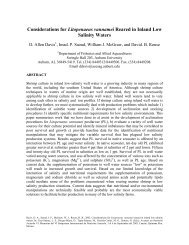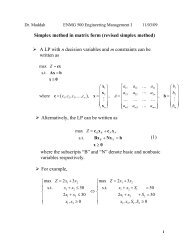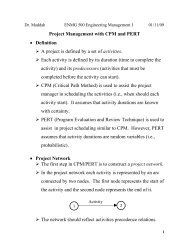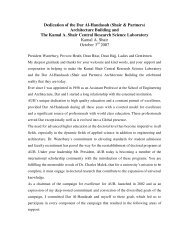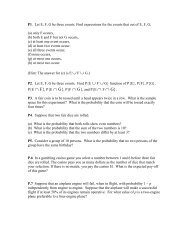Volatility Smiles
Volatility Smiles
Volatility Smiles
You also want an ePaper? Increase the reach of your titles
YUMPU automatically turns print PDFs into web optimized ePapers that Google loves.
‣ The differences between these two bring about thephenomena we call volatility smiles and skews.‣ It makes sense to consider volatility a characteristic of theunderlying asset.‣ This assumption means that for the same stock, options withdifferent strike prices should have the same impliedvolatility.‣ If actual volatility were constant, and if the Black-Scholesmodel were correct and if people prices options correctly thenthat would hold; however this is rarely the case. Example: Foreign Currency Options‣ If we take options with the same maturity on a certain foreigncurrency that vary only in strike price we can calculate theimplied volatility for each one.‣ Keep in mind that since they share the same underlying assetwe expect the volatility to remain constant regardless of thestrike price. However, plotting gives the following,2
‣ The volatility is relatively low for at-the-money options andgets progressively higher as an option moves either into orout of the money.‣ We gain some analytical insight into why this occurs if wecompare the implied volatility distribution with thelognormal one with the same mean and standard deviation.‣ Consider a deep out-of-the-money call with strike priceabove K 2 . This derivative will only pay off if the exchangerate closes above K 2 , and according to the above figure theprobability of this happening is higher for the implieddistribution than the lognormal one. A higher probabilitywill generate a higher price, which in turn means a higherimplied volatility.‣ The same is true of a deep out-of-the-money put with strikeprice below K 1 .3
Empirical Results‣ We have just shown that the smile used by traders for foreigncurrency options implies that they consider that thelognormal distribution understates the probability of extrememovements in exchange rates, but is this accurate?‣ A study of 12 different exchange rates over a 10-year periodwas conducted.‣ The first step was to calculate the standard deviation of dailypercentage change in each exchange rate. Then to note howoften the actual percentage of change exceeded one standarddeviation, two, three…etc. The final step was to calculatehow often this would have happened if the percentagechanges had been normally distributed. The lognormalmodel implies that percentage changes are almost exactlynormally distributed over a one day time period.‣ The table provides evidence to support the existence of heavytails and the volatility smile used by traders.4
‣ Note: In the mid-80’s a few traders knew about the heavytails of foreign exchange probability distributions. Theybought deep out-of-the-money call and put options on avariety of different currencies and proceeded to make lots ofmoney. This is because the lognormal model that everyoneelse accepted underpriced those options and more of themended up in-the-money than it expected. By the late-80’s,traders realized that foreign currency should be priced with avolatility smile and the trading opportunity disappeared. Reasons for the Smile in Foreign Currency Options‣ For an asset to have a price with a lognormal distribution twoconditions must be met.‣ Its volatility must be constant and the price of the assetshould change smoothly with no jumps. Neither of these issatisfied with exchange rates.‣ The percentage impact of jumps on both prices and volatilitysmiles becomes less pronounced as the maturity of the optionis increased.‣ This is because the jumps tend to get averaged out and so thejumps appear to be smoother. This makes the derivativeconform to the assumed lognormality more readily. Equity Options‣ Equity (stock) options exhibit a volatility skew5
‣ The volatility used to price a low-strike-price option (i.e. adeep our-of-the-money put or a deep in-the-money call) issignificantly higher than that used to price a high strike-priceoption.‣ Once again, we turn to a comparison of the probabilitydistribution of the implied volatility and a lognormal onewith the same mean and standard deviation for an analyticalexplanation.6
‣ To the left (low-strike-price) the implied volatility shows ahigher probability than the lognormal one of equalparameters.‣ This means that these options are priced higher than oneswith larger strike-prices. This is not the case to the right,thus the skew. Reasons Behind the Skew‣ Interestingly, there was no marked volatility skew beforeOctober 1987.‣ It has been suggested that the market crash of ’87 instilledfear into traders who therefore trade lower strike-priceoptions more heavily in order to hedge their positions, thusaffecting the price of these options with their increaseddemand.‣ This explanation has some empirical support. A steepeningin the skew is observed when the S&P 500 (the marketportfolio) declines while a flattening accompanies its rise.‣ This shows that the worse the market is doing, the morepeople trade low-strike-price options in apprehension of amarket crash.‣ Another explanation is that as a company’s equity declines, itbecomes riskier and therefore more volatile.‣ When the opposite happens a company is viewed as safer andtherefore has lower volatility.7
Equity Options when Expecting a Large Jump‣ In order to better illustrate the behavior of equity options weshall consider the following example.‣ Consider a stock at $50 that is expected, due to the comingdetermination of a currently unknown event, to changestrongly in one month. The risk-free rate is 12%‣ We can calculate the prices of 1-month European puts andcalls with different strike prices and from them find theimplied volatility. The results are,8
‣ Plotting the implied volatility against the strike-price revealsa volatility “frown”.‣ The volatility implied from an option with a strike-price of$50 will overprice an option with a strike-price that is furtherfrom being at-the-money.‣ Remember: traders use volatility smiles to allow fornon-lognormality.The volatility smile defines the relationship between theimplied volatility of an option and its strike price. <strong>Volatility</strong> Surfaces‣ Implied volatilities are frequently used to quote the prices ofoptions.9
‣ The implied volatility of a European option on a particularasset as a function of strike price and time to maturity isknown as the asset's volatility surface.‣ Every day traders and brokers estimate volatility surfaces fora range of different underlying assets from the market pricesof options.‣ Some points on a volatility surface for a particular asset canbe estimated directly because they correspond to activelytraded options. The rest of the volatility surface is typicallydetermined by interpolating between these points.‣ If the assumptions underlying Black-Scholes held for anasset, its volatility surface would be flat and unchanging. Inpractice the volatility surfaces for most assets are not andchange stochastically.10
<strong>Volatility</strong> Modeling‣ Since the Black-Scholes option pricing formulae requirevolatility as an input we need a way to accurately assess it.‣ Our understanding of volatility is that of meta-data that is nota real characteristic of an asset, but a descriptive one of itsprice. Given this difficulty, how can we best model it? Simple Models‣ The simplest way to account for volatility is assuming itconstant. However, it is clear that this approach isinapplicable to trading when examining real stock prices andtheir changing volatilities.‣ If we believe that the volatility is close to constant and onlyvaries slowly then we can consider the volatility of recentreturns only. Setting a window of N we have,‣ There are obvious major problems associated with thisvolatility measure; because the returns are equally weightedwe will get a plateau-effect associated with a large return.11
‣ If there is a large one-day return it will increase the volatilityinstantaneously, but the estimate of volatility will stay raiseduntil N days later when that return drops out of the sample. Exponentially Weighted Moving Average‣ Now let us consider time-varying volatility. We don’t justhave one σ but must consider σ n , our estimate of the volatilityon the nth day, using data available up to that point.‣ Exponentially Weighted Moving Average estimates eliminatethe plateau-effect of the simpler moving average volatilityestimate.‣ The earlier models give every entry an equal weight whereasthis model weighs the most recent ones most and decays theweight exponentially as the returns become further.12
‣ The parameter λ must be greater than zero and less than one.The more recent the return, the more weight is attached. Thesum extends back to the beginning of time.‣ The coefficient of 1 − λ ensures that the weights all add toone. This expression can be simplified to, Mean Reversion and GARCH Models‣ If we believe that volatility tends to vary about a long-termmean σ, then we could use,13
‣ Here there is a weighting assigned to each of the long-runvolatility estimate and the current estimate based on the last nreturns. This is called an ARCH model (for AutoregressiveConditional Heteroscedasticity).‣ Alpha is the weight that we give to our estimate of “meanvolatility” and the remainder is split between n instances ofrecent volatility measures.‣ If we combine the ARCH and Exponential Weighting, wearrive at a Generalized ARCH (or GARCH) model,‣ All notations maintain their identity, alpha arbitratingbetween our “mean volatility” and recorded data, and lambdadistributing the weights of recent measures in an exponentialfashion.14



